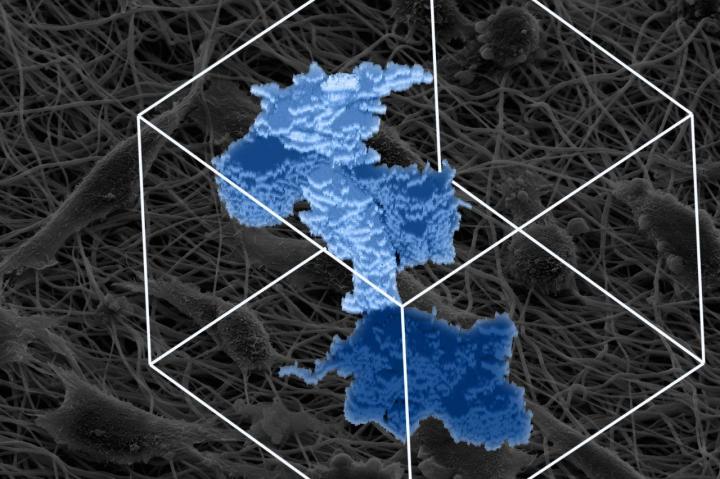
Credit: Virginia Tech
A simple slice of the finger sends a complex series of interactions between types of cells into motion. Two types of cells in particular, called macrophages and fibroblasts, work together to clean up and repair the fibers destroyed by the cut.
As they do so, they influence each other, they influence the microscopic environment around them, and they are influenced by that reaction — all in the quiet pursuit of healing the wound.
But little is known about these environments and how macrophages and fibroblasts assist or inhibit each other when they move through a fibrous and interconnected tissue environment. Researchers at Virginia Tech recently published a study chronicling previously unknown connections and influences between these cells and their environments — an advancement that may help with development of biomedical devices that respond more effectively to wounds or tumors.
“A major aspect of our research is that it just really illustrates how complex all these different components are going on inside a person’s body,” said Andrew Ford, a Ph.D. student in chemical engineering and first author of the paper.
The insight gained by the team’s research could guide the design of biomedical solutions for attacking tumors or treating wounds faster by manipulating the environment of the macrophages and fibroblasts.
While applications are already being explored using these ideas, the recently published research provides validation in addition to a closer look at the interactions between the cells and the variables of their environment.
Macrophages and fibroblasts exist in humans’ connective tissue, which is found underneath the outer layer of skin. This connective tissue forms a space, the extracellular matrix, which provides structural support for other tissues in the body.
Within this matrix, the fibroblasts exist to secrete proteins that build up and repair the connective tissue or break apart the matrices to help dissolve proteins and enable movement. Macrophages, however, tend to go on the attack against material that is foreign or appears to be in the wrong place.
When working together, fibroblasts form long, 3D tunnels, which are then used by macrophages to move.
In the instance of a wound or cut to the finger, macrophages activate and go on the offensive, gobbling up the tissues displaced from the cut. Meanwhile, the fibroblasts work quickly to secrete protein and repair the damaged area.
In the absence of fibroblasts, the researchers found that macrophages were unable to move when the fibrous environment was very densely connected. When operating in comparatively looser fibers, the fibroblasts aligned fibers in a way that produced tracks for the macrophages to follow.
“This study provides a fundamental understanding on how these two cell types work with each to move in an interconnected tissue structure,” said Padma Rajagopalan, the Robert E. Hord Jr. Professor of Chemical Engineering and program director of Interdisciplinary Graduate Education Program on Computational Tissue Engineering.
Fibroblasts used chemical and mechanical processes to form tunnels and align fibers. In their study, the researchers showed that chemical processes may have played a more significant role in the formation of tunnels than mechanical processes.
Both cells worked together to clear away debris that resulted from the tunnel formation, showing a coordination between these two cells as they move in a tissue-like structure. Together, the two cells, guided by the extracellular matrix conditions they exist in, can either assist or inhibit each other.
“It’s this whole cascading cycle,” Ford said.
The manipulation of the environment around these cells could lead to breakthroughs in treatments for wounds and tumors — especially tumors within lung and breast tissues, which most closely resemble the fiber conditions in the experimental setup.
Ford and colleague Sophia Orbach, a Ph.D. student in chemical engineering, completed this research in the lab of and under the direction of Rajagopalan.
The research was funded by the National Science Foundation, with additional support provided by the Virginia Tech Institute for Critical Technology and Applied Science.
###
Media Contact
Lindsey Haugh
[email protected]
Original Source
https:/




